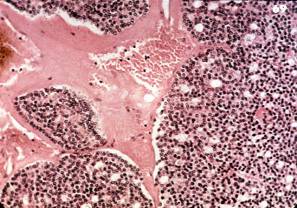 Acinic cell carcinoma is a rare type of cancer that affects the salivary glands, occurring mainly in the parotid gland, which is the largest salivary gland, located near the jawbone just in front of the ear.
Acinic cell carcinoma is a rare type of cancer that affects the salivary glands, occurring mainly in the parotid gland, which is the largest salivary gland, located near the jawbone just in front of the ear.
It is a slow-growing cancer that can develop in people of all ages, although most symptoms appear in middle age. Women are more likely to develop the disease than men.
Acinic cell carcinoma used to be thought of as a benign tumor because of its slow growth.
However, research has made the World Health Organization reclassify the carcinoma as malignant because of the high probability that it may recur and metastasize to the lungs, bone, lymph nodes and other areas.
Patients with acinic cell carcinoma present symptoms such as an enlarged salivary gland, nausea and vomiting, and loss of appetite and weight.
Little is known about what causes a person to develop acinic cell carcinoma. To date, whatever evidence research studies have gathered on this type of cancer can only point the reader towards theories.
One theory is that previous radiation exposure, particularly that treating thyroid disease, causes the cancer.
Research has shown that environmental and ionizing radiation can cause cancer of the salivary glands, which may include acinic cell carcinoma.
Heredity may also possibly play a role in the carcinoma’s development, and so with chronic wood dust inhalation.
To prevent the development of the disease, exposure to wood dust must be minimized. Industrial-grade masks must be worn by woodworkers, and the work areas must be properly ventilated.
People must also stay away from radioactive areas/sites, such as nuclear weapons testing areas, and minimize their exposure to X-ray machines and other naturally occurring radioactive material.
Treatment for acinic cell carcinoma consists mainly of surgery followed by radiation sessions. The tumor is taken out completely in surgery; incomplete removal usually means a low chance of survival.
If this happens, radiation is given to make sure all cancer cells are killed, to prevent recurrence of the disease.
Of the various types of radiation treatments available to patients, only fast neutron beam radiation has been found to be effective, especially for inoperable tumors after conventional radiation has been shown to be ineffective.
Fast neutron beam radiation could also be considered as the primary treatment option instead of surgery. If fast neutron beam radiation is not available, conventional radiation may still be given, but in its accelerated hyper fractionated form.
















